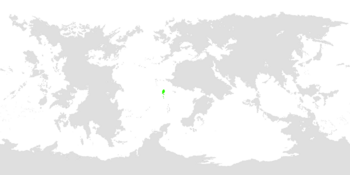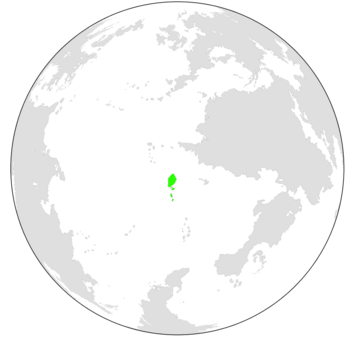Hazala: Difference between revisions
No edit summary |
|||
| (12 intermediate revisions by 2 users not shown) | |||
| Line 38: | Line 38: | ||
|demonym = Hazalan | |demonym = Hazalan | ||
|government_type = [[wikipedia:Federation|Federal]] Republic | |government_type = [[wikipedia:Federation|Federal]] Republic | ||
|leader_title1 = | |leader_title1 = Vhintigip (President) | ||
|leader_name1 = [[Nonhaj Huut]] | |leader_name1 = [[Nonhaj Huut]] | ||
|leader_title6 = | |leader_title6 = | ||
| Line 45: | Line 45: | ||
|sovereignty_type = | |sovereignty_type = | ||
|sovereignty_note = | |sovereignty_note = | ||
|established_event1 = First settlers arrive in | |established_event1 = First settlers arrive in Ulungo | ||
|established_date1 = 900 AC | |established_date1 = 900 AC | ||
|established_event3 = Sáillinnciadi sailors first arrived on Hazalan shores, conquest of Hazala | |established_event3 = Sáillinnciadi sailors first arrived on Hazalan shores, conquest of Hazala | ||
| Line 87: | Line 87: | ||
|HDI_change = 0.5512 | |HDI_change = 0.5512 | ||
|HDI_category = medium | |HDI_category = medium | ||
|currency = [[ | |currency = [[Hazalan Banl]] (*Hbl) | ||
|currency_code = KLV | |currency_code = KLV | ||
|time_zone = | |time_zone = | ||
| Line 108: | Line 108: | ||
In 1535, Sáillinnciadi sailors first arrived on Hazalan shores. What began as trade soon became conquest, and by 1570 all of the islands were under colonial rule. Arboran rule caused another wave of extinction, largely due to the introduction of rats, cats, and pigs, as well as habitat destruction. One of the most important events of the colonial period on Hazalan culture was the introduction of Vayonism, specifically Reformed Vayonism, which was hybridised with local beliefs to form a new, uniquely Hazalan form of Vayonism. | In 1535, Sáillinnciadi sailors first arrived on Hazalan shores. What began as trade soon became conquest, and by 1570 all of the islands were under colonial rule. Arboran rule caused another wave of extinction, largely due to the introduction of rats, cats, and pigs, as well as habitat destruction. One of the most important events of the colonial period on Hazalan culture was the introduction of Vayonism, specifically Reformed Vayonism, which was hybridised with local beliefs to form a new, uniquely Hazalan form of Vayonism. | ||
In 1942, growing tensions with the homeland lead to a full on revolution. With foreign backing, Sáillinnciad recognized Hazala as an independent nation. After several decades of instability and dictatorships, the islands entered an era of relative prosperity in the late 1980’s. Today, the main industries are tourism (mainly the pristine beaches, beautiful coral reefs, and comparatively well preserved forests) | In 1942, growing tensions with the homeland lead to a full on revolution. With foreign backing, Sáillinnciad recognized Hazala as an independent nation. After several decades of instability and dictatorships, the islands entered an era of relative prosperity in the late 1980’s. Today, the main industries are tourism (mainly the pristine beaches, beautiful coral reefs, and comparatively well preserved forests), the export of cocoa and sugar, and narcotics. | ||
==Etymology== | ==Etymology== | ||
| Line 114: | Line 114: | ||
==History== | ==History== | ||
=== | ===Pre-human arrival=== | ||
{{main|Paleontology of Hazala}} | |||
The island Ulungo first began to form about 70 million years ago, during the Late Cretaceous. This uplifting has revealed a treasure trove of marine fossils. The most common fossils found in Hazalan limestone are mollusks (in the form rudists and ammonites), followed by crinoids and crustaceans. Fragmentary fossils of ''Nyctosaurus gracilis'' have also been found. Easily the best known fossil is a nearly complete, fully articulated ''Cardiocorax mukulu'', which is currently in the main hall of the Hazalan Museum of Natural History in Bourandi. | |||
=== | ===Tribal Period=== | ||
=== | ===Colonial Era=== | ||
=== | ===Hazalan Revolution=== | ||
=== | ===Post-independence dictatorships=== | ||
=== | ===Ghanhi's Revolution=== | ||
=== | ===Modern day=== | ||
==Geography== | ==Geography== | ||
===Administrative Divisions=== | ===Administrative Divisions=== | ||
Hazala is broken up into 26 divisions named hazula ("area"). 19 of them are on the island of Ulungo, 5 representing the highland forests alone. Each hazula works like a smaller version of the national government, with elected positions following the same set of rules. | |||
===Topography=== | ===Topography=== | ||
| Line 143: | Line 146: | ||
===Government=== | ===Government=== | ||
The Hazalan government is a presidential federal republic. There are three branches of government; the executive branch, the legislative branch, and the judicial branch. Each is lead by the Vhintigip (roughly "high leader"), Speaker of the Hut, and the High Court, respectively. | |||
====Political Parties==== | ====Political Parties==== | ||
| Line 151: | Line 154: | ||
===Defense=== | ===Defense=== | ||
{{main|Hazalan Armed Forces}} | |||
===Foreign Relations=== | ===Foreign Relations=== | ||
| Line 157: | Line 161: | ||
===Agriculture=== | ===Agriculture=== | ||
===Narcotics=== | |||
===Energy=== | ===Energy=== | ||
| Line 201: | Line 207: | ||
===Literature=== | ===Literature=== | ||
While most Hazalan literature isn't well known outside of the country, author and activist Bangto Echibe's ''[[The Songbirds Went Away]]'' is perhaps the most famous piece of Diharan literature. It chronicles the lives of several family members shortly before and after the establishment of colonial rule over the region. In addition to this, Echibe has written many short stories, many dealing with colonialism and native Hazalan culture. His works have inspired a wave of Hazalan authors, including Ghinda Holut, author of ''[['Under Bourandi]]'', an urban fantasy novel set in the nation's capital. | |||
===Media=== | ===Media=== | ||
| Line 209: | Line 216: | ||
===Sports=== | ===Sports=== | ||
===Usage of narcotics=== | |||
==Social Issues== | ==Social Issues== | ||
Latest revision as of 22:44, 16 April 2020
Republic of Hazala Hazala
(Hazalan) | |
|---|---|
|
Flag | |
| Motto: '"!" The One Blessed Isles! | |
| Anthem: Majagrundi (traditional battle cry). | |
 | |
 | |
| Capital and largest city | Bourandi |
| Ethnic groups (2014) |
|
| Religion | Reformed Communion of Hazala, traditional Hazalan |
| Demonym(s) | Hazalan |
| Government | Federal Republic |
• Vhintigip (President) | Nonhaj Huut |
| Establishment | |
• First settlers arrive in Ulungo | 900 AC |
• Sáillinnciadi sailors first arrived on Hazalan shores, conquest of Hazala | 1535-1570 AC |
• Hazalan independence recognized | 1947 AC |
• Water (%) | XXX |
| Population | |
• 2020 estimate | 2,237,900 |
• 2019 census | 2,234,000 |
| GDP (PPP) | 2016 estimate |
• Total | $57 billion |
• Per capita | XXX |
| Gini (2015) | 22.1 low |
| HDI (2018) | 0.5512 medium |
| Currency | Hazalan Banl (*Hbl) (KLV) |
| Time zone | UTC-11:00, -10:00 |
| Date format | dd-mm-yyyy |
| Driving side | right |
| Calling code | +474 |
| ISO 3166 code | KL |
| Internet TLD | .kl, .kila, .klrak, .krk |
Hazala, officially the Republic of Hazala (Dánila Ripóna gi Hazala), is an island nation in the Mid-Allonian Ocean. The islands first formed about 70 MYA, caused by subduction of the [X] plate. Many unique endemic flora and fauna have inhabited the islands, including ratites, rails, stem-sirenians, terrestrial crocodilians, and many different groups of birds. About 1,100 years ago, human settlers from western Dihara arrived on the shores of Ulungo, bringing with them dogs, chickens, and yams. Many native species went extinct, including all the massive gharun (giant. Flightless birds), the cattle-sized bout, and all of the terrestrial crocodiles except for the arboreal janjir (also known as the Hazalan tree crocodile).
For about 650 years, Hazala remained isolated from the outside world. Many tribes split off, and farming communities appeared in the highlands of Ulungo. Narcotics played an important part in pre-contact culture, being consumed for religious, casual, ritualistic, and celebratory purposes - some particularly bold and confident warriors would get intoxicated before battle. Speaking of, wars were more ritualistic than the Auroran concept of it, with low casualties and more over minor disputes than major ideological or religious reasons. Chickens served as the main livestock, with dog consumption being considered taboo (except in extreme circumstances).
In 1535, Sáillinnciadi sailors first arrived on Hazalan shores. What began as trade soon became conquest, and by 1570 all of the islands were under colonial rule. Arboran rule caused another wave of extinction, largely due to the introduction of rats, cats, and pigs, as well as habitat destruction. One of the most important events of the colonial period on Hazalan culture was the introduction of Vayonism, specifically Reformed Vayonism, which was hybridised with local beliefs to form a new, uniquely Hazalan form of Vayonism.
In 1942, growing tensions with the homeland lead to a full on revolution. With foreign backing, Sáillinnciad recognized Hazala as an independent nation. After several decades of instability and dictatorships, the islands entered an era of relative prosperity in the late 1980’s. Today, the main industries are tourism (mainly the pristine beaches, beautiful coral reefs, and comparatively well preserved forests), the export of cocoa and sugar, and narcotics.
Etymology
History
Pre-human arrival
The island Ulungo first began to form about 70 million years ago, during the Late Cretaceous. This uplifting has revealed a treasure trove of marine fossils. The most common fossils found in Hazalan limestone are mollusks (in the form rudists and ammonites), followed by crinoids and crustaceans. Fragmentary fossils of Nyctosaurus gracilis have also been found. Easily the best known fossil is a nearly complete, fully articulated Cardiocorax mukulu, which is currently in the main hall of the Hazalan Museum of Natural History in Bourandi.
Tribal Period
Colonial Era
Hazalan Revolution
Post-independence dictatorships
Ghanhi's Revolution
Modern day
Geography
Administrative Divisions
Hazala is broken up into 26 divisions named hazula ("area"). 19 of them are on the island of Ulungo, 5 representing the highland forests alone. Each hazula works like a smaller version of the national government, with elected positions following the same set of rules.
Topography
Climate
Biodiversity
Environmental Issues
Politics and Government
Government
The Hazalan government is a presidential federal republic. There are three branches of government; the executive branch, the legislative branch, and the judicial branch. Each is lead by the Vhintigip (roughly "high leader"), Speaker of the Hut, and the High Court, respectively.
Political Parties
Corruption Allegations
Political Rights
Defense
Foreign Relations
Economy & Infrastructure
Agriculture
Narcotics
Energy
Oil
Renewable Energy
Industry
Transport
Rail
Road
Air
Water
Mining & Manufacture
Tourism
Healthcare
Education
Science & Tech
Demographics
Largest Cities
Ethnic Groups
Education
Literacy Rates
Religion
Culture
Literature
While most Hazalan literature isn't well known outside of the country, author and activist Bangto Echibe's The Songbirds Went Away is perhaps the most famous piece of Diharan literature. It chronicles the lives of several family members shortly before and after the establishment of colonial rule over the region. In addition to this, Echibe has written many short stories, many dealing with colonialism and native Hazalan culture. His works have inspired a wave of Hazalan authors, including Ghinda Holut, author of 'Under Bourandi, an urban fantasy novel set in the nation's capital.

